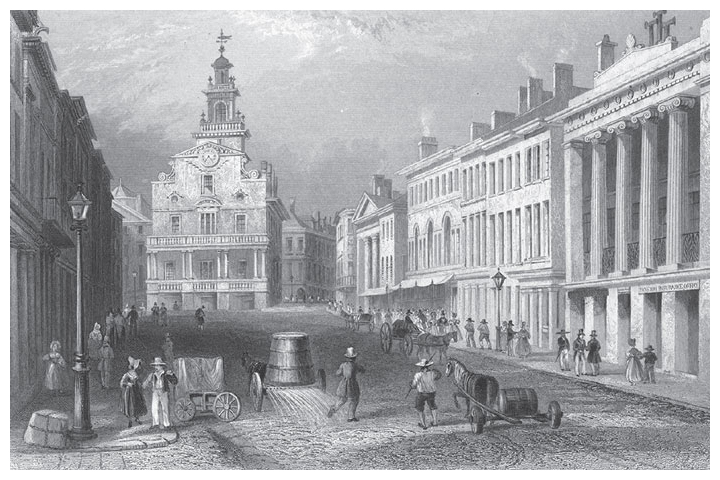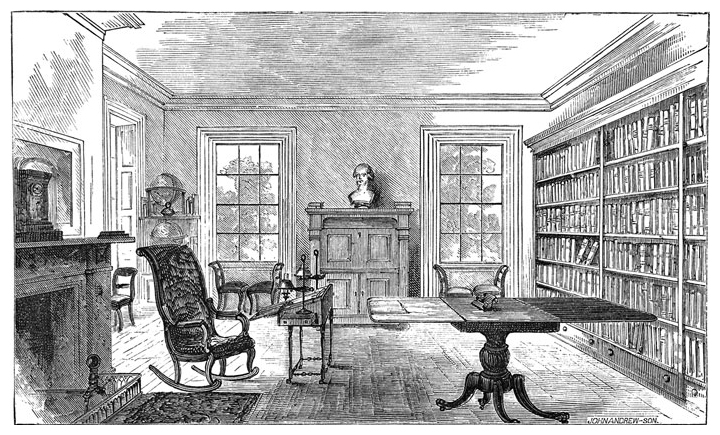This Article From Issue
November-December 2016
Volume 104, Number 6
NATHANIEL BOWDITCH AND THE POWER OF NUMBERS: How a Nineteenth-Century Man of Business, Science, and the Sea Changed American Life. Tamara Plakins Thornton. 402 pp. University of North Carolina Press, 2016. $35.
In his lifetime, from 1773 to 1838, Nathaniel Bowditch was showered with honors both in the United States and abroad. He was inducted into the Royal Societies of England and Scotland, as well as the Royal Irish Academy; he gained the admiration of such luminaries as Charles Babbage; and he was hailed by at least one American newspaper as “the first Mathematician in our country.” His publications bridged the worlds of applied mathematics and scholarly theory. Yet today few mathematicians recognize his name.

Nathaniel Bowditch and the Power of Numbers, by Tamara Plakins Thornton, revives the memory of this American savant. Bowditch’s mathematical brilliance, combined with an obsessive demand for precision, launched him on a lifelong quest to improve the quality and clarity of widely varied types of information. The results of his work echoed through many aspects of early American life, from navigation to commerce to academia. Thornton, a history professor at the University of Buffalo who focuses on early American culture and intellectual history, is well qualified to tell the story of Bowditch’s astonishing life. She does so with a deep and sensitive understanding of science and commerce in the young republic.
Until 1823 Bowditch lived in Salem, Massachusetts. Today Salem prompts images of witch hunts and public executions, largely because of Arthur Miller’s popular play,
The Crucible, about the witch trials that took place there in 1692 and 1693. (The town itself works hard to keep a kitschy satanic spirit alive. Even the police cars sport pictures of broom-borne witches.) However, the Salem where Bowditch was born in 1773 was none of that. It was a thriving port and prosperous commercial center that would soon become the sixth-largest city in the United States.
At age 12, after only three years of school, young Nathaniel became an apprentice clerk at a ship chandlery owned by relatives. It would be the first of many times his mother’s thriving family proved beneficial to him over the years. As a clerk he kept sales records of the manifold goods needed to repair ships and provision crews: handsaws, calking irons, cooking utensils, fish hooks, and brimstone (used for fumigation to ward off contagious diseases) comprise but a small sample.
Keeping books in the late 18th century required familiarity with many currencies and standards of weight and measure, and of course facility with numbers. Bowditch’s son recalled that his father “always kept a slate by his side, and, when not occupied by the duties of the shop, he was busied with his favorite pursuit of arithmetic.” Bowditch taught himself algebra. Later he managed to learn enough Latin to begin reading Euclid’s
Elements
and Newton’s
Principia
. Then with knowledge of some French, which he acquired from a refugee who had fled Haiti during its revolution, Bowditch began reading new mathematics research published by France’s L’Académie Royale des Sciences. Throughout his life he would continue to learn by himself, somehow always finding the requisite time.
Beginning in 1795, when he was 22, Bowditch made four ocean voyages, serving as the representative of the ship’s owner, responsible for the sale and purchase of cargo. His destinations included distant ports such as Manila, Sumatra, and India. These trips were dangerous, made even more so by conflicts between England and France. Although the United States was neutral and its citizens legally free to sail, law had little force at sea. Being boarded by British and French warships and having cargo or crew seized was an ever-present risk.
Becoming lost in the middle of a vast ocean was another hazard. Navigation at sea required knowing precise longitude, which at the time still generally meant reckoning by the Moon. Bowditch carried a copy of John Moore’s
New Practical Navigator
, the most popular maritime reference book of his day. Still, finding longitude was a serious problem. Although the marine chronometer, invented by John Harrison in 1773, could be used to solve it, such a device was too expensive for most sailors. Instead they relied on the
lunar method
, using Moore’s tables to convert their measurements of the Moon into geographical positions. Yet even a tiny error could lead to disaster. Bowditch’s mix of commercial and mathematical instincts inspired him to create better tables to make sure that valuable ships were not lost due to navigational errors that could run a ship into rocks at night or aground on a foggy day.
During his voyages, Bowditch found errors in Moore: 8,000 of them, in fact. Edmund Blunt, a printer in Newburyport, Massachusetts, who had planned to publish a revised version of Moore, saw a commercial opportunity and persuaded Bowditch to produce his own manual. Bowditch’s
New American Practical Navigator
first appeared in 1802 and became an immediate success. The word
Bowditch
became synonymous with the volume, even finding its way into Herman Melville’s novel
Moby-Dick
. The book remains in use today and is revised regularly to accommodate changes in technology. (The U.S. Hydrographic Office purchased the copyright in 1866, and the book is available for free online:
http://bit.ly/2df3LhP
.)
The myriad calculations Bowditch performed as he checked Moore required an extraordinary mind. To construct his own book, Moore had employed numerous “calculators,” men and women who worked daily on the needed computations. Bowditch, however, did all the calculations for his
New American Practical Navigator
himself, using spare moments on both land and sea. (And he did it by age 29, while working full-time.) Before his book was published, Bowditch, the calculating prodigy, was a source of pride for Salem. With the release of the
Navigator
, his mathematical reputation would spread throughout the nation and sail across oceans.
After his fourth sea voyage, and before the
Navigator
was published, Bowditch was invited to join the East India Marine Society, an educational and charitable association for shipmasters and navigators who had sailed at least as far as the African continent’s Cape of Good Hope. His job was to analyze and arrange the society’s journals filled with the records of sea journeys. As a member of an elite group of mariners and businessmen, he shared valuable information and exchanged favors. Once again, family connections had helped propel the 27-year-old’s career.

FROM THE MOMENT we are born, standardized forms chase us: birth certificates, school applications, bank deposit slips, insurance claim forms, and, irritatingly, more. Benjamin Franklin, who famously remarked that only death and taxes are certain, lived in a simpler world than ours, one with no blanks to fill nor boxes to check. His was the world in which Bowditch grew to manhood—a world that he would help organize, systematize, and transform. Certainly a phenomenal ability to compute was one characteristic that distinguished the man; another was his unbending insistence on uniformity and order. In his world there was no place for sloppiness or error. Such things offended him deeply on a personal level.
Business practices in early 19th-century America would seem dangerously casual to a modern observer. Vital records were often nothing but paper scraps stuffed into drawers or impaled on metal spikes. At the East India Marine Society, Bowditch had helped to introduce printed forms for shipmasters to share commercial and navigational information, described as “blank forms and printed directions to be furnished Members going abroad, for the purpose of collecting nautical information and procuring natural curiosities.” For greater accuracy, transactions would be recorded when they happened, not at a later, more convenient time.
In 1827 he accepted an important post as actuary at Boston’s Massachusetts Hospital Life Insurance Company, known locally as the Life Office, bringing with him the same zeal for systemizing information and business processes that had proved successful at the East India Marine Society. At the Life Office he insisted that procedures be followed rigorously and without exception, even for Boston’s elite. Thornton concludes, “This business of having a mathematician run the Life Office created mixed responses, from praise to resentment, but ultimately the city’s upper crust appreciated the advantages of Bowditch’s methods.”
Not everyone was happy with the mathematician’s methods. Thornton tells this part of Bowditch’s story with the combination of solid scholarship and psychological insight that we find throughout her book. In 1826, after being made a member of Harvard’s governing board, an extraordinary honor for someone lacking a college degree, Bowditch orchestrated the removal of the college’s financially inept president, John Thornton Kirkland. Although Kirkland was certainly incompetent, he was also beloved by both students and alumni. Local newspapers relayed furious letters and editorials, at least one referring to Bowditch dismissively as “a Salem sailor.” Alumnus Ralph Waldo Emerson, a Bostonian, wrote, “tis queer that little men should . . . spill the President out of the window.” The
Boston Gazette
insisted that Bowditch’s “mind [was] so abstracted from all softer sentiments, by mathematical calculations as to have treated [Kirkland] with harshness, or insult, or irreverence.”
The belief that mathematics contracts the mind was not unique to the United States. Charles Babbage, the English mathematician who designed calculating engines at about the same time that Bowditch was making a name for himself in the States, found similar sentiments hurled at him. The attitude remains common today, a fact that might help explain why so many gifted students choose not to pursue mathematics as a profession.
Despite the ad hominem attacks, Bowditch never stopped thinking of himself as a mathematician, and he continued to work hard for professional recognition. His name can be found on solutions of problems published in small magazines such as
Mathematical Diary
, recreational journals intended for readers with an amateur interest in math. (There would be no serious mathematics journal in the United States until the
American Journal of Mathematics
began publishing in 1878.) Although facility with numbers was recognized by the public as a sign of intelligence, mathematics was not generally regarded as an important academic subject.
Bowditch knew that European mathematicians such as Carl Friedrich Gauss and Pierre-Simon Laplace were opening wide new avenues—the former in algebra, geometry, number theory, and astronomy and the latter in calculus and probability—with their profound discoveries. Those were the sort of people he wanted to impress. Finding mistakes in nautical tables or solving problems of elementary geometry would never earn respect overseas. Something bigger and much better was needed.
The first subjects we master tend to shape us. When he was 26 years old, Bowditch began wrestling with Laplace’s
Mécanique Céleste
. It’s worth noting that his engagement with Laplace’s work began so early in Bowditch’s life: Ever the overachiever, he was improving navigation tables, systematizing shipping procedures, and coming to grips with Laplace all while in his 20s. When Bowditch first encountered his work, Laplace had just published two of the eventual five volumes that would attempt to reduce all celestial phenomena to consequences of the law of gravity. (Although Thornton’s book is masterful in nearly every respect, she mistakenly asserts that Laplace’s work proves that our Solar System is stable. Alas, this problem remains unsolved, and so we must all go to bed each night with a small measure of unease.)
Few readers in the United States had sufficient preparation to understand Laplace’s work. Bowditch did, thanks to countless hours he’d spent in self-guided studies, and he labored to translate
Mécanique Céleste
into English. Knowledge of spherical trigonometry, conic sections, and differential calculus would be assumed on the part of the reader, but Bowditch would review such topics in an appendix. Ample footnotes would fill in the many steps left to the reader by Laplace. The project would occupy many of Bowditch’s spare hours for the remainder of his life. Four volumes of his translation were successively published between 1829 and 1839. Bowditch died the year before the fourth volume would appear.
In the view of his fellow citizens, Bowditch’s translation would finally force Europe to acknowledge our nation’s intellectual abilities. Philadelphia’s
National Gazette
wrote that it had “raised [Bowditch] in the estimation of the most eminent savants of Europe, to the highest rank in the intellectual world.” The European reaction was certainly more muted, although readers there were impressed and Bowditch received congratulatory letters and new honors. The clarity of his exposition was not the only quality praised by reviewers. Admired too was the beautiful typography of the book. It is a pity that Thornton’s book did not include an image of a typical page. (Happily, Bowditch’s book can now be viewed at the Internet Archive:
http://bit.ly/2dCORld.) The work was a boon to serious students, and it helped to spread interest in Laplace’s work in the United States.
Yet Bowditch knew that his work was no mathematical breakthrough. In the final days of his life he referred to his translation as a “mere bagatelle” that soon would become obsolete, a book that nobody would care to read. He had dreamed of being a mathematician of the order of Laplace, but he had fallen far short. “La Place originates things which it would have been impossible for me to have originated... La Place was of the Newton class; and there is the same difference between La Place and myself as between Archimedes and Euclid.” (Euclid, possibly the greatest mathematics expositor of all time, was, in Bowditch’s opinion, “a second-rate mathematician.”)
It is understandable that Bowditch never became a mathematician of world class. The direction of his career was steered by the strong currents of revolution and nation building. Yet for the very same reason, the story of Nathaniel Bowditch is fascinating. Tamara Plakins Thornton tells it with intelligence, warmth, and abundant sympathy.
Daniel S. Silver is a professor in the Department of Mathematics and Statistics at the University of South Alabama. Much of his research explores the relationship between knots and dynamical systems. Other active interests include the history of science and the psychology of invention.




American Scientist Comments and Discussion
To discuss our articles or comment on them, please share them and tag American Scientist on social media platforms. Here are links to our profiles on Twitter, Facebook, and LinkedIn.
If we re-share your post, we will moderate comments/discussion following our comments policy.